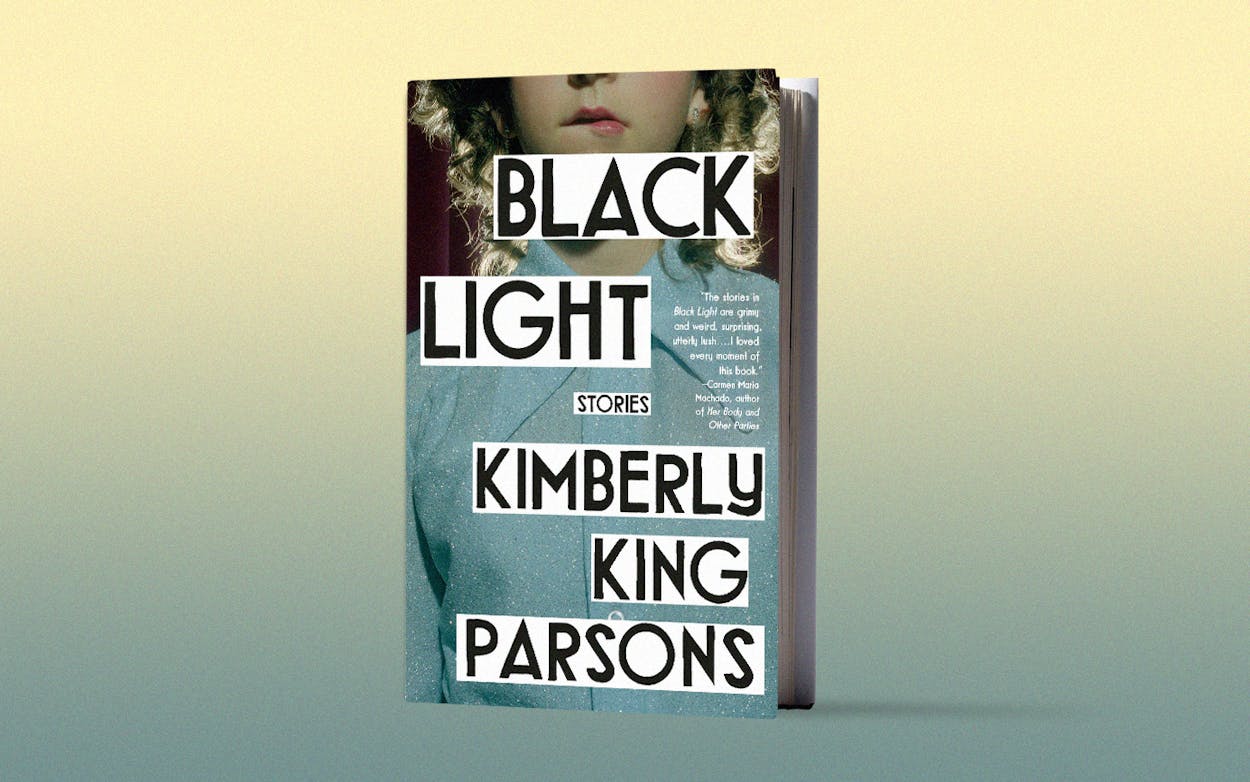When her family moved from Lubbock to the suburbs of Dallas, Kimberly King Parsons—the author of the newly released short story collection Black Light—pretended not to have an accent. Unlike the heroines in her fiction, who proudly stand out, hollering and singing long after they’re kicked out of the church choir, Parsons wanted to fit in. She was in the fifth grade.
“I wanted to talk how my friends talked,” she says over the phone. “To sound ‘universal,’ or like what actors sound like.” Parsons has always been drawn to the intricacies of language, in childhood and college (she studied English—William Faulkner in particular—at the University of Texas at Dallas), and now as an author.
In Dallas, she sang with a few “ridiculous bands” while writing stories set in places like New York or the West Coast—places she imagined living. She left Texas in 2005, to study fiction at Columbia University. But there, Parsons came to realize that her home state—with its “SPFs and ant beds”—was at the heart of her fiction. In New York City, she wrote the Texas-based stories that would later comprise her debut, Black Light, some of which were first published in The Paris Review, Black Warrior Review, and No Tokens.
From afar, she came to appreciate the very language of her childhood she’d tried to distance herself from. Colloquialisms—like “bless your precious heart,” said cloyingly, sticky with sarcasm—root these stories in their respective settings, whether it’s Lubbock, Dallas, or Houston. Her characters listen to “bug song” and eat “heart food from scratch.” One character’s mother is described as the “free-range type.” “I realized, of course, these [stories] are about home,” Parsons says.
The mythologies of Texas can also bear down oppressively in Parsons’s fiction. In the story “Foxes,” for instance, an oil-rich cowboy leaves his wife and daughter (the latter of whom idealizes him) behind. Some characters in Black Light are happily situated, while others hotel hop, looking to leave. There are antsy, roughhousing kids and marriages that are just about through. There are women who find other women to love, chipping each other’s nail-polished hands to look edgy, and mothers who mean well. “My mom is all over this book. [Her] voice in my ear all the time, all the time, all the time,” Parsons says. “I had to listen to the same story over and over. It was like a prayer, or like a song.”
She cites her background, as well as the music of conversation, as influences. Her favorite acts are great lyricists: the late David Berman, Bill Callahan. But because she’s sung with her share of synth-heavy bands, she also has an appreciation for the “wild weirdness of glitter rock.” Her characters likely would, too: they drive around on mushrooms and play a game called “glow bowling” (hurling balls under a black light, which, for one narrator, has a dissociative effect).
Parsons also draws from other Texas writing luminaries. Cormac McCarthy’s Blood Meridian is “beautiful and devastating,” she says. Parsons especially likes Sandra Cisneros, and how she aptly captures “child language and the cadence of children speaking, the social mores of children.” “She doesn’t rely on precocity,” Parsons adds. Precocious young girls are central to Parsons’s own stories—and these girls not privy to their own brilliance when they prattle off lines like: “Have you heard of our ecosystem? Have you heard of my inner beauty and my outer beauty?”
Black Light also features girls with scabs and scars and bug collections, tough girls and girls who act tough in order not to seem so lonely. “I gravitate toward characters on the fringes,” Parsons says. “People with different religious views and political views. I’m interested in how a place shapes them, and also in how it doesn’t.” This sensibility makes itself plain in stories like “The Soft No,” where a young narrator resents her city’s Buddy Holly statue, but she’s okay with its “big, big sky.” She plays games with her brother, lobbing fistfuls of earth at neighborhood kids. Her mother keeps her makeup in a tackle box and likes practicing on her: “I hate the way makeup chokes my skin,” she complains.
It makes sense that some of these characters—the ones on the margins—might feel stuck and restless. The person who created them, after all, went through something similar. Their experiences in their small towns or boarding schools have a Southern Gothic feel to them, and Parsons seems comfortable writing in that genre, particularly when she exposes the beauty in an image that might otherwise be considered grotesque. In “Guts,” for instance, the narrator’s med student boyfriend names each of her body parts one by one, as homework or as foreplay. She hadn’t heard most of the words before, but some of them are sonorous, “like poetry or caught phlegm, depending.”
This appreciation for the grotesque, and the unexpected intimacies that arise therein, might mean a bug-infested Texas basement or a styrofoam cup of car-warmed Mountain Dew. Or, as Parsons says,“a hair on a hotel room bed. It’s not gross or disgusting; it’s like, no, actually, another person was here. I was taking things I found gross and thinking, ‘How can I make this beautiful?’”






